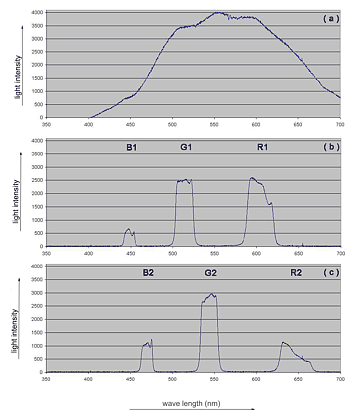

| Interference Filters (Wavelength multiplex visualisation) / Infitec™ |
A fairly new stereo system is the so-called "Wavelength multiplex visualisation" by using Interference filters.
Light entering the human eye is separated into three spectral ranges by three types of receptors that are related to the primary colors blue, green and red. According to the three types of receptors in the human eye, color displays are built up by three pixel types. Each pixel type is emitting light within the sensitivity range of the correlated receptor type.
The spectral width of the emission is normally not of decisive importance. This parameter is determining merely the saturation of the primary color. Most saturated colors are obtained by displays with very narrow bandwidth primary colors, such as the laser display where almost monochromatic primary colors are used. In wavelength multiplex displays, however, another feasibility being inherent in displays with narrow-bandwidth primary colors is used, namely the possibility of transmitting parallel image information in different triplets of primary colors. In order to assign the information to the corresponding receiver (which is the eye of the viewer) the information has to be filtered by analogy with the filtering of transmitter signals in broadcasting by the oscillatory circuit at the input. At optical frequencies the corresponding circuits are represented by high Q interference filters that consist of a multilayer deposition of dielectric materials on, for instance, a glass substrate. These filters can be integrated in standard eyeglasses.
The Q value (that is related to the selectivity of the filters) is determining the maximum size of image content that can be displayed in parallel. Physically, interference filters are coupled resonators where the number of resonators is determining the selectivity of the filters. Increasing the number of resonators increases the selectivity of the filters.
Taking two triplets B1-G1-R1 and
B2-G2-R2, for instance, the
wavelength multiplex principle can
be used to display stereoscopic
images (see graphics below). To increase the
number of viewers of a virtual
object in parallel (multiple-viewer
functionality),
the number of triplets has to be
increased to twice the number of
viewers (two stereoscopic
perspectives for each viewer). The
boundary condition that has to be
observed for all the triplets is that
all monochromatic primary colours
(B1 ... Bn, G1 ... Gn, R1 ... Rn) are
lying within the bandwidth of the
respective human eye receptor.
 |
Two optical Infitec™ filter split the colour spectrum in 2 parts: one for the left and one for the right eye information. |
Infitec™ is a passive working stereo projection procedure. Thus the Infitec™ 3D-glasses do not require a power source contrasting them from the 3-D-Glasses of active stereo shutter technology.
Besides that, there is a feature of the wavelength multiplex scheme regarding image contrast which is especially advantageous to the front projection situation: as the narrow-band interference filters permit only part of the daylight to pass, interference filters do enhance efficiently the contrast ratio in light rooms which may be of interest also to mono-display applications (one wavelength triplet only).
Another aspect of practical relevance may be the feasibility of depositing the dielectric multilayer, which causes the interference filter characteristic, onto glasses with optical correction. So, users with eyeglasses do not need extra-glasses as they can use correction glasses with the specific dielectric multilayer deposition.
 |
|

| Back to the Stereoscopy.com FAQ Page |
